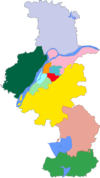Yuhuatai Memorial Park of Revolutionary Martyrs

Yuhuatai Memorial Park of Revolutionary Martyrs (雨花台烈士陵园) is a park and tourist site in the Yuhuatai District of Nanjing, Jiangsu Province, China.[1] The name Yuhuatai comes from yu (rain), hua (flower), tai (platform). A prominent feature of the park is a statue of nine figures.[2][3] The statue commemorates the communists killed by the Kuomintang.[4][5]
History
During the Republic of China period, Yuhuatai was used as a torture chamber where over thousands of communists were executed, including Deng Zhongxia.[6] In 1940, after the establishment of Wang Jingwei's puppet government, some agents of Bureau of Investigation and Statistics were also killed in Yuhuatai. After the end of the Anti-Japanese War, many Japanese war criminals were executed here. [7][8]
After the founding of the People's Republic of China, Yuhuatai was set up as a mausoleum of revolutionary martyrs, planting trees, building roads in 1950. Then in 1970, the Nanjing Government built the 10 meter-high North Martyrdom and 14 meter-long group of martyrs sculpture there. In 1984, the local government built a memorial hall in the southern part of the mausoleum and a 42-meter-high monument on the summit of the main peak. In 1988, Yuhuatai was included in the third batch of National Key Cultural Relic Protection Unit.[9]
In 2010, Yuhuatai Martyrs' Memorial Museum added Zhu Chi, Hua Pinzhang, Han Xianyuan and Gao Zhisong, four generals of the National Revolutionary Army who sacrificed their lives in the Battle of Yuhua in the defense of Nanjing in the War of Resistance Against Japanese Aggression.[10]
Executed Japanese War Criminals
The following is a list of Japanese war criminals of World War II who were executed at Yuhuatai:[11]
- Takashi Sakai (酒井隆): Supreme Governor of the Hong Kong War Office.
- Junichi Tanaka (田中軍吉): Squadron Leader of the Sixth Division of the Japanese Invasion Dispatch Army.
- Toshiaki Mukai (向井敏明): Second Lieutenant of the Ninth Division of the 16th Japanese Invasion Dispatch Corps.
- Tsuyoshi Noda (野田毅): Second Lieutenant of the Ninth Wing of the 16th Division of the Japanese Invasion Forces.
- Hisao Tani (谷寿夫): Lieutenant General of the Imperial Japanese Army, the person mainly responsible for the Nanjing Massacre.[12]
- Mitsuyoshi Tsurumaru (鶴丸光吉): a member of the Kyushu Kokura Kempeitai of the Imperial Japanese Army, responsible for the massacre of non-military personnel during the Nanjing Massacre.[13]
Gallery
-
North Main Gate
-
Yuhuatai Martyrs' Cemetery
-
Yuhuatai Martyrs' Cemetery
-
Martyrs' Cemetery
-
Martyrs' Cemetery
-
Memorials
-
Tomb of the Well-Known Martyrs
-
Revolutionary Martyrs' Martyrdom Place
-
Loyal Soul Pavilion
-
Yuhuatai
-
Yuhuatai
See also
References
- ^ Famous Tourist Attractions in China, page 258
- ^ Smith, I.C.; West, N. (2021). Historical Dictionary of Chinese Intelligence. Historical Dictionaries of Intelligence and Counterintelligence. Rowman & Littlefield Publishers. p. 178. ISBN 978-1-5381-3020-9. Retrieved 2024-04-29.
- ^ Rem Sapozhnikov (October 2008). "Yuhuatai (Rain Flower Terrace) hill (Yǔhuātái lièshì língyuán – 雨花台 烈士陵园) The Memorial to the Martyrs of the Revolution".
- ^ Vogel, Ezra F. (2011). Deng Xiaoping and the Transformation of China. Harvard University Press. ISBN 9780674055445.
- ^ East Asian History. Institute of Advanced Studies, Australian National University. 1998. Retrieved 2024-04-29.
- ^ Denton, K.A. (2013). Exhibiting the Past: Historical Memory and the Politics of Museums in Postsocialist China. UPCC book collections on Project MUSE.: History. University of Hawaii Press. p. 114. ISBN 978-0-8248-4006-8. Retrieved 2024-04-29.
- ^ Ju-ao, M. (2021). The Tokyo Trial and War Crimes in Asia. Springer Nature Singapore. p. 227. ISBN 978-981-15-9813-5. Retrieved 2024-04-29.
- ^ Kushner, B. (2024). The Geography of Injustice: East Asia's Battle Between Memory and History. Cornell University Press. p. 128. ISBN 978-1-5017-7402-7. Retrieved 2024-04-29.
- ^ "国务院关于公布第三批全国重点文物保护单位的通知_中国概况_中国政府网". www.gov.cn. Retrieved 29 April 2024.
- ^ "雨花台烈士纪念馆5日改陈开馆 新增5位烈士事迹-新华网". m.xinhuanet.com. Retrieved 29 April 2024.
- ^ 影像与断想: 抗战回望 (in Chinese). 山东画报出版社. 2002. ISBN 978-7-80603-626-6. Retrieved 2024-04-29.
- ^ 东京审判亲历记 (in Chinese). 上海交通大学出版社. 2016. p. 81. ISBN 978-7-313-15080-6. Retrieved 2024-04-29.
- ^ 「南京大虐殺のまぼろし」 (in Japanese). 文藝春秋. 1983. Retrieved 2024-04-29.
- CS1 Chinese-language sources (zh)
- CS1 Japanese-language sources (ja)
- Articles with short description
- Short description is different from Wikidata
- Articles containing Japanese-language text
- Commons category link is on Wikidata
- Coordinates on Wikidata
- Parks in Nanjing
- Cemeteries in Nanjing
- Major National Historical and Cultural Sites in Jiangsu











